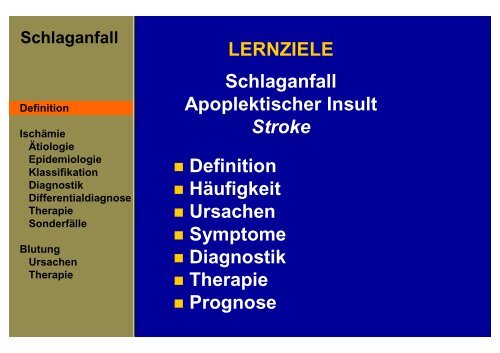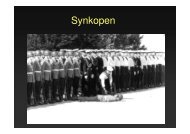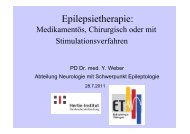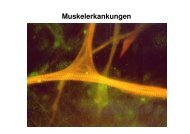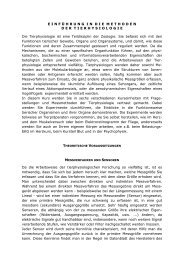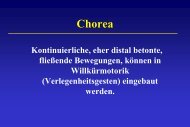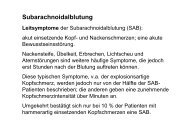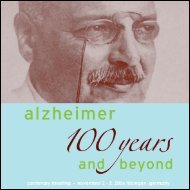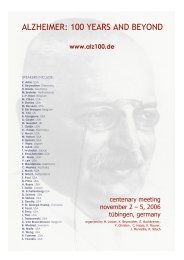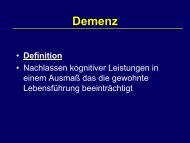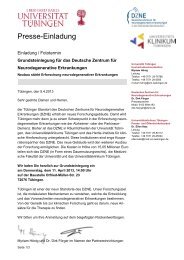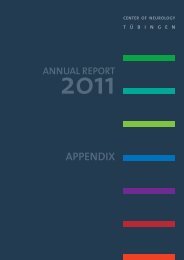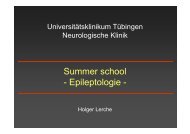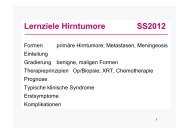Schlaganfall der
Schlaganfall der
Schlaganfall der
Erfolgreiche ePaper selbst erstellen
Machen Sie aus Ihren PDF Publikationen ein blätterbares Flipbook mit unserer einzigartigen Google optimierten e-Paper Software.
<strong>Schlaganfall</strong><br />
Definition<br />
Ischämie<br />
Ätiologie<br />
Epidemiologie<br />
Klassifikation<br />
Diagnostik<br />
Differentialdiagnose<br />
Therapie<br />
Son<strong>der</strong>fälle<br />
Blutung<br />
Ursachen<br />
Therapie<br />
LERNZIELE<br />
<strong>Schlaganfall</strong><br />
Apoplektischer Insult<br />
Stroke<br />
• Definition<br />
• Häufigkeit<br />
• Ursachen<br />
• Symptome<br />
• Diagnostik<br />
• Therapie<br />
• Prognose
<strong>Schlaganfall</strong><br />
Definition<br />
Ischämie<br />
Ätiologie<br />
Epidemiologie<br />
Klassifikation<br />
Diagnostik<br />
Differentialdiagnose<br />
Therapie<br />
Son<strong>der</strong>fälle<br />
Blutung<br />
Ursachen<br />
Therapie<br />
LERNZIELE<br />
<strong>Schlaganfall</strong><br />
Apoplektischer Insult<br />
Stroke<br />
• TIA (Symptome 24 h)<br />
• progressiver Infarkt<br />
• Intracranielle Blutung (ICB)<br />
typische hypertensive ICB Stammganglien<br />
atypische ICB<br />
Lobärhämatom<br />
• Subarachnoidalblutung (SAB)<br />
*Zur Beachtung: in Zeiten des MRT zeigt sich:<br />
30 bis 50 % <strong>der</strong> TIA-Pat. haben klinisch stumme Infarkte.<br />
Hält eine TIA länger als 6 h an, liegt bei 90% im MRT ein Infarkt vor
<strong>Schlaganfall</strong><br />
<strong>Schlaganfall</strong><br />
Ursachen<br />
Definition<br />
Ischämie<br />
Ätiologie<br />
Epidemiologie<br />
Klassifikation<br />
Diagnostik<br />
Differentialdiagnose<br />
Therapie<br />
Son<strong>der</strong>fälle<br />
Blutung<br />
Ursachen<br />
Therapie<br />
• thrombotisch<br />
• Makroangiopathie (30-40%)<br />
• Mikroangiopathie (20-30%)<br />
• kardioembolisch (25-40%)<br />
• kardiale Embolie (AA bei VHF)<br />
• paradoxe Embolie (PFO)<br />
• Gerinnungsstörungen (
<strong>Schlaganfall</strong><br />
Definition<br />
Ischämie<br />
Ätiologie<br />
Epidemiologie<br />
Klassifikation<br />
Diagnostik<br />
Differentialdiagnose<br />
Therapie<br />
Son<strong>der</strong>fälle<br />
Blutung<br />
Ursachen<br />
Therapie<br />
Ischämie<br />
Intracranielle<br />
Blutung<br />
<strong>Schlaganfall</strong><br />
(70 - 80%)<br />
arteriosklerotische Thrombose<br />
arterio-arterielle Embolie<br />
kardiale Embolie<br />
Mikroangiopathie, lakunärer Infarkt<br />
nicht-arteriosklerotische Angiopathie<br />
Grenzzoneninfarkt, hämodynamische Urs.<br />
Vaskulitiden mit zerebraler Beteiligung<br />
(20 – 30 %)<br />
Ursachen<br />
Intrazerebrale Massenblutung (ca. 15%)<br />
Subarachnoidalblutung (5%)<br />
Sinusvenenthrombose, Stauungsblutung<br />
(
<strong>Schlaganfall</strong><br />
Definition<br />
Ischämie<br />
Ätiologie<br />
Epidemiologie<br />
Klassifikation<br />
Diagnostik<br />
Differentialdiagnose<br />
Therapie<br />
Son<strong>der</strong>fälle<br />
Blutung<br />
Ursachen<br />
Therapie<br />
• Inzidenz 250 / 100.000 Einw.<br />
• pro 80 Mio. EW <strong>der</strong> BRD:<br />
150 - 200.000 Schlaganfälle / J.<br />
• 1 bis 1,5 Mio. <strong>Schlaganfall</strong>-<br />
Patienten leben in <strong>der</strong> BRD<br />
• teuerste Erkrankung in den<br />
Industrielän<strong>der</strong>n
<strong>Schlaganfall</strong><br />
Gefässterritorien s.a. Anatomie<br />
Definition<br />
Ischämie<br />
Ätiologie<br />
Epidemiologie<br />
Klassifikation<br />
Diagnostik<br />
Differentialdiagnose<br />
Therapie<br />
Son<strong>der</strong>fälle<br />
Blutung<br />
Ursachen<br />
Therapie<br />
Territorialinfarkt Endstrominfarkt Grenzzoneninfarkt<br />
An<strong>der</strong>e Verteilungsmuster<br />
sind verdächtig auf an<strong>der</strong>e Ursachen<br />
z.B. eine Sinusvenenthrombose!
<strong>Schlaganfall</strong><br />
Definition<br />
Ischämie<br />
Ätiologie<br />
Epidemiologie<br />
Klassifikation<br />
Diagnostik<br />
Differentialdiagnose<br />
Therapie<br />
Son<strong>der</strong>fälle<br />
Blutung<br />
Ursachen<br />
Therapie<br />
Akut-Diagnostik<br />
• Klinische Untersuchung<br />
Stroke Skala NIHSS<br />
• RR, Puls, Temperatur, Glucose<br />
• EKG<br />
• CCT (mit CT-Angiographie und<br />
Perfusionsbil<strong>der</strong>n) o<strong>der</strong> cMRT<br />
• Dopplersonographie
Computertomographie beim akuten <strong>Schlaganfall</strong><br />
Erkennen eines arteriellen Verschlusses<br />
-- dense media sign „dichte Media“<br />
Blutnachweis im Nativ-CT<br />
Erkennung des ischämischen Hirnödems
<strong>Schlaganfall</strong><br />
Definition<br />
Ischämie<br />
Ätiologie<br />
Epidemiologie<br />
Klassifikation<br />
Diagnostik<br />
Differentialdiagnose<br />
Therapie<br />
Son<strong>der</strong>fälle<br />
Blutung<br />
Ursachen<br />
Therapie<br />
Im Intervall nach <strong>der</strong> Akutversorgung<br />
• Echokardiographie<br />
• MRT mit Diffusionswichtung u.<br />
MR-Angiographie<br />
• konventionelle Angiographie<br />
• Langzeit EKG / RR<br />
• Thrombophilie-Screening u.<br />
Vaskulitis-Labordiagnostik
<strong>Schlaganfall</strong><br />
Definition<br />
Ischämie<br />
Ätiologie<br />
Epidemiologie<br />
Klassifikation<br />
Diagnostik<br />
Differentialdiagnose<br />
Therapie<br />
Son<strong>der</strong>fälle<br />
Blutung<br />
Ursachen<br />
Therapie<br />
<strong>Schlaganfall</strong>:<br />
einige Differentialdiagnosen<br />
• Todd’sche Parese nach Krampfanfall<br />
• Migräne mit prolongierter Aura o<strong>der</strong><br />
familiäre hemiplegische Migräne<br />
• Entzündung (MS-Läsion; Abszess)<br />
• Einblutung in Tumor / Metastase
<strong>Schlaganfall</strong><br />
Definition<br />
Ischämie<br />
Ätiologie<br />
Epidemiologie<br />
Klassifikation<br />
Diagnostik<br />
Differentialdiagnose<br />
Therapie<br />
Son<strong>der</strong>fälle<br />
Blutung<br />
Ursachen<br />
Therapie<br />
Stroke Unit: “Time is Brain”<br />
• Optimierung von<br />
• RR, Puls, Glc, Temp.<br />
• Lyse<br />
• systemisch: 3 Std. (4.5 Std. ECASS-3)<br />
• lokal: bis 6 Std.<br />
• evtl. bis 6 Std. bei Perfusions-/<br />
Diffusions-Mismatch (MRT-Kriterien)<br />
• Basilaris: keine zeitliche Grenze<br />
• frühe Sekundärprophylaxe<br />
• Thrombozytenaggregationshemmer<br />
• Vollheparinisierung<br />
• frühe Hemikraniektomie<br />
• bei Ischämien > 2/3 des rechten<br />
Mediastromgebietes,
<strong>Schlaganfall</strong><br />
Stroke Unit: “Time is Brain”<br />
Definition<br />
Ischämie<br />
Ätiologie<br />
Epidemiologie<br />
Klassifikation<br />
Diagnostik<br />
Differentialdiagnose<br />
Therapie<br />
Son<strong>der</strong>fälle<br />
Blutung<br />
Ursachen<br />
Therapie
<strong>Schlaganfall</strong><br />
Indikation zur Thrombolyse<br />
• Ischämischer <strong>Schlaganfall</strong><br />
Definition<br />
Ischämie<br />
Ätiologie<br />
Epidemiologie<br />
Klassifikation<br />
Diagnostik<br />
Differentialdiagnose<br />
Therapie<br />
Son<strong>der</strong>fälle<br />
Blutung<br />
Ursachen<br />
Therapie<br />
• Zeitpunkt des Beginns
<strong>Schlaganfall</strong><br />
Indikation zur Thrombolyse<br />
Definition<br />
Ischämie<br />
Ätiologie<br />
Epidemiologie<br />
Klassifikation<br />
Diagnostik<br />
Differentialdiagnose<br />
Therapie<br />
Son<strong>der</strong>fälle<br />
Blutung<br />
Ursachen<br />
Therapie
<strong>Schlaganfall</strong><br />
Stroke Unit: “Time is Brain”<br />
Definition<br />
Ischämie<br />
Ätiologie<br />
Epidemiologie<br />
Klassifikation<br />
Diagnostik<br />
Differentialdiagnose<br />
Therapie<br />
Son<strong>der</strong>fälle<br />
Blutung<br />
Ursachen<br />
Therapie
Beziehung zwischen zerebraler Blutversorgung<br />
und Hirnfunktion: Enstehung eines Infarkts
Beziehung zwischen zerebraler Blutversorgung<br />
und Hirnfunktion: Enstehung eines Infarkts<br />
Core<br />
Penumbra
Abhängig von<br />
Kollateralen
<strong>Schlaganfall</strong><br />
Definition<br />
Ischämie<br />
Ätiologie<br />
Epidemiologie<br />
Klassifikation<br />
Diagnostik<br />
Differentialdiagnose<br />
Therapie<br />
Son<strong>der</strong>fälle<br />
Blutung<br />
Ursachen<br />
Therapie<br />
Risikofaktoren für Schlaganfälle<br />
<strong>der</strong> „normale“ Mensch<br />
x20 hochgradige Carotis-Stenose<br />
x8 Vorhofflimmern<br />
x5 Hypertonie<br />
x3 Diabetes mellitus<br />
x2,7 Bewegungsmangel<br />
x2,5 Nikotin<br />
x2 pro Dekade ab 55. Lj.<br />
0,4%/J.<br />
Sekundärprophylaxe<br />
x2 bei Afro-Amerikanern<br />
x2 bei erstgradigen Verwandten<br />
x2 Dyslipidämie<br />
x2 Homocysteinämie<br />
x1,3 bei Männern<br />
<strong>der</strong> „Risikopatient“ Primärprophylaxe<br />
10% / Jahr und mehr<br />
<strong>Schlaganfall</strong>
<strong>Schlaganfall</strong><br />
Definition<br />
Ischämie<br />
Ätiologie<br />
Epidemiologie<br />
Klassifikation<br />
Diagnostik<br />
Differentialdiagnose<br />
Therapie<br />
Son<strong>der</strong>fälle<br />
Blutung<br />
Ursachen<br />
Therapie<br />
Kausale Therapie im Intervall<br />
• Behandlung von Risikofaktoren<br />
• Cholesterin, Nikotin, Hypertonie, Diabetes<br />
• Stenosebehandlung (ACI)<br />
• Thrombendarteriektomie (TEA)<br />
• Stent<br />
• Sekundärprophylaxe<br />
• Thrombozytenaggregationshemmer<br />
- ASS<br />
- ASS + Dipyridamol (Aggrenox)<br />
- Clopidogrel (Plavix, Iscover)<br />
• ACE-Hemmer<br />
• Lipidsenker (Statine)<br />
protektiver Effekt<br />
auf Endothel<br />
• Marcumar (bei VHF, Dissektionen)<br />
• Verschluß eines persistierenden For. ovale
<strong>Schlaganfall</strong><br />
Stroke Outcome nach Thrombolyse (Rankin Scale)<br />
Definition<br />
Ischämie<br />
Ätiologie<br />
Epidemiologie<br />
Klassifikation<br />
Diagnostik<br />
Differentialdiagnose<br />
Therapie<br />
Son<strong>der</strong>fälle<br />
0-90 Minuten<br />
placebo<br />
rt-PA<br />
91-180 180 Minuten<br />
placebo<br />
Intravenöse Thrombolyse nach<br />
zerebraler Ischämie<br />
Einschränkung <strong>der</strong> Funktion (Rankin) nach 90 Tagen<br />
Keine/Minimale (0-1) Mittelgradige (2-3) Schwere (4-5)<br />
29<br />
29<br />
42<br />
25<br />
26<br />
22<br />
26<br />
29<br />
18<br />
Tod<br />
0-1 2-3 4-5 Tod<br />
21<br />
19<br />
16<br />
Blutung<br />
Ursachen<br />
Therapie<br />
rt-PA<br />
181-270 Minuten<br />
placebo<br />
0-1<br />
32<br />
42<br />
21<br />
21<br />
17<br />
2-3 4-5 Tod<br />
26<br />
31<br />
12<br />
rt-PA<br />
37<br />
24<br />
26<br />
13
<strong>Schlaganfall</strong><br />
Definition<br />
Ischämie<br />
Ätiologie<br />
Epidemiologie<br />
Klassifikation<br />
Diagnostik<br />
Differentialdiagnose<br />
Therapie<br />
Son<strong>der</strong>fälle<br />
Blutung<br />
Ursachen<br />
Therapie<br />
NNT number needed to treat...um 1 <strong>Schlaganfall</strong> zu verhin<strong>der</strong>n
Sekundärprophylaxe<br />
Thrombozytenaggregationshemmer<br />
- ASS<br />
- ASS + Dipyridamol (Aggrenox)<br />
- Clopidogrel (Plavix, Iscover)<br />
Definition<br />
Ischämie<br />
Ätiologie<br />
Epidemiologie<br />
Klassifikation<br />
Diagnostik<br />
Differentialdiagnose<br />
Therapie<br />
Son<strong>der</strong>fälle<br />
Blutung<br />
Ursachen<br />
Therapie
Sekundärprophylaxe und Risiko<br />
Definition<br />
Ischämie<br />
Ätiologie<br />
Epidemiologie<br />
Klassifikation<br />
Diagnostik<br />
Differentialdiagnose<br />
Therapie<br />
Son<strong>der</strong>fälle<br />
Blutung<br />
Ursachen<br />
Therapie
Wirkungsmechanismen <strong>der</strong><br />
Thrombozyteninhibitoren<br />
Acetylsalicyl-<br />
säure<br />
AA<br />
ADP<br />
Ticlopidin<br />
Clopidogrel<br />
Purinerger Rezeptor<br />
cAMP, cGMP<br />
TXA 2<br />
cAMP <br />
AMP, GMP<br />
Dipyri-<br />
damol<br />
PTR<br />
Fibrin<br />
GPIIb/IIIa<br />
IIIa<br />
GPIIb/IIIa<br />
IIIa<br />
GPIIb/IIIa<br />
IIIa =<br />
GP Blocker:<br />
Abciximab<br />
Tirofiban<br />
Eptifibatide<br />
PTR = thrombozytärer Thromboxanrezeptor, , GP = Glykoprotein, , AA = Arachidonsäure,<br />
TXA 2<br />
= Thromboxan A 2
CHADS-Score:<br />
Risikoabschätzung einer zerebralen<br />
Ischämie bei Vorhofflimmern:<br />
CHAD >2: Indikation zur Antikoagulation<br />
CHADS 2<br />
Risk<br />
Score<br />
C – congestive heart failure 1<br />
H- hypertension 1<br />
A - age > 75 1<br />
D – diabetes 1<br />
S - stroke or TIA 2<br />
CHADS2<br />
score<br />
Patients<br />
(n = 1733)<br />
Adjusted<br />
stroke rate<br />
% per year<br />
0 120 1.9<br />
1 463 2.8<br />
2 523 4.0<br />
3 337 5.9<br />
4 220 8.5<br />
5 65 12.5<br />
From ESC AF Guidelines<br />
http://www.escardio.org/guidelines-surveys/escguidelines/GuidelinesDocuments/guidelines-afib-FT.pdf<br />
6 5 18.2
Statine und <strong>Schlaganfall</strong>-Risiko<br />
Risiko-Reduktion<br />
Relative Risikoreduktion<br />
Statine vs. Plazebo (%)<br />
35<br />
30<br />
25<br />
20<br />
15<br />
10<br />
5<br />
0<br />
32<br />
CARE<br />
23<br />
4S<br />
19<br />
LIPID<br />
32<br />
HPS<br />
11<br />
WOS<br />
Sekundärprävention<br />
Primär-/<br />
Sekundärprävention<br />
Primärprävention
Empfehlungen zur Therapie mit Statinen<br />
Optimaler Zielwert Empfehlung<br />
Keine KHK<br />
< 2 Risikofaktoren* < 160 mg/% Diät, Medikation: > 190 mg/%<br />
> 2 Risikofaktoren* < 130 mg/% Diät, Medikation: > 160 mg/%<br />
KHK, <strong>Schlaganfall</strong>, AVK < 100 mg/% Diät, Medikation: > 130 mg/%<br />
Risikofaktoren:<br />
> 45 Jahre,<br />
> 60 Jahre,<br />
positive Familienanamnese,<br />
Nikotin, Hochdruck, Diabetes, HDL < 35 mg/%<br />
National Cholesterol Education Program (NCEP), JAMA 2001;285:2486-2497.<br />
2497.
<strong>Schlaganfall</strong><br />
Definition<br />
Ischämie<br />
Ätiologie<br />
Epidemiologie<br />
Klassifikation<br />
Diagnostik<br />
Differentialdiagnose<br />
Therapie<br />
Son<strong>der</strong>fälle<br />
Blutung<br />
Ursachen<br />
Therapie<br />
Behandlungsindikationen bei Stenosen<br />
<strong>der</strong> hirnversorgenden Gefäße<br />
• ACI Stenosen<br />
•Symptomatische Stenose ≥70% (Duplex)<br />
•Asymptomatische Stenose ≥70% bei<br />
• Nachweislich niedriger<br />
Komplikationsrate des Chirurgen<br />
• Vor allem Männer und<br />
Alter< 75Jahre<br />
•Intrakranielle Stenosen –<br />
noch keine einheitlichen<br />
Kriterien
Symptomatische Karotisstenose<br />
< 50% 50 - 69% > 70%<br />
Geringgradige Stenose<br />
< 75 Jahre, weiblich,<br />
<strong>Schlaganfall</strong> > 3 Monate<br />
Nur visuelle Symptome<br />
Keine intrakranielle Stenose<br />
Mikroangiopathie<br />
Niedriges <strong>Schlaganfall</strong>risiko<br />
Geringgradige Stenose<br />
> 75 Jahre, männlich,<br />
<strong>Schlaganfall</strong> < 3 Monate<br />
Hemisphär. Symptome<br />
Intrakranielle Stenose<br />
Keine Mikroangiopathie<br />
Hohes <strong>Schlaganfall</strong>risiko<br />
Konservative Therapie<br />
Karotis-TEA o<strong>der</strong> Stent (UKT)<br />
nach: Sacco RL, NEJM 2001;345:1113.
<strong>Schlaganfall</strong><br />
Definition<br />
Neue Möglichkeiten <strong>der</strong> Akutbehandlung<br />
Intracranieller Stenosen<br />
- intracranielle Stents<br />
- Thrombektomie-Devices<br />
Ischämie<br />
Ätiologie<br />
Epidemiologie<br />
Klassifikation<br />
Diagnostik<br />
Differentialdiagnose<br />
Therapie<br />
Son<strong>der</strong>fälle<br />
Blutung<br />
Ursachen<br />
Therapie<br />
Neuroradiologie Tübingen
<strong>Schlaganfall</strong><br />
Dissektion: A. carotis int. o<strong>der</strong> A. vertebralis<br />
Definition<br />
Ischämie<br />
Ätiologie<br />
Epidemiologie<br />
Klassifikation<br />
Diagnostik<br />
Differentialdiagnose<br />
Therapie<br />
Son<strong>der</strong>fälle<br />
Blutung<br />
Ursachen<br />
Therapie<br />
• daran denken!!<br />
• junge Patienten<br />
• keine vaskulären<br />
Risikofaktoren<br />
• Horner-Syndrom bei ACI<br />
• Nackenschmerz bei VA<br />
•Therapie: Antikoagulation<br />
NEJM 2001
<strong>Schlaganfall</strong><br />
Basilaristhrombose<br />
Definition<br />
Ischämie<br />
Ätiologie<br />
Epidemiologie<br />
Klassifikation<br />
Diagnostik<br />
Differentialdiagnose<br />
Therapie<br />
Son<strong>der</strong>fälle<br />
Blutung<br />
Ursachen<br />
Therapie<br />
•Kopfschmerzen,<br />
Schwindel, Doppelbil<strong>der</strong>,<br />
Verwirrtheit,<br />
Bewußtseinsstörung,<br />
Dysarthrie,<br />
Hirnnervenausfälle,<br />
• Hemi- o<strong>der</strong> Tetraparese<br />
•häufig Prodromi /<br />
fluktuieren<strong>der</strong> Verlauf
<strong>Schlaganfall</strong><br />
Basilaristhrombose<br />
Definition<br />
Ischämie<br />
Ätiologie<br />
Epidemiologie<br />
Klassifikation<br />
Diagnostik<br />
Differentialdiagnose<br />
Therapie<br />
Son<strong>der</strong>fälle<br />
Blutung<br />
Ursachen<br />
Therapie<br />
•dran denken (vor allem<br />
bei Abklärung <strong>der</strong><br />
Bagatelle „Schwindel“)<br />
•CCT plus Angiographie/<br />
Doppler<br />
•Bei Verdacht sofortige<br />
Angiographie und lokale<br />
Lyse
<strong>Schlaganfall</strong><br />
Blutungen<br />
Definition<br />
Ischämie<br />
Ätiologie<br />
Epidemiologie<br />
Klassifikation<br />
Diagnostik<br />
Differentialdiagnose<br />
Therapie<br />
Son<strong>der</strong>fälle<br />
Blutung<br />
Ursachen<br />
Therapie<br />
• Hypertonie<br />
• sek. bei Ischämie<br />
• Gefäßmißbildungen<br />
• Aneurysma<br />
• Angiom<br />
• Durale AV-Malformation (-Fistel)<br />
• Kavernom<br />
• Gerinnungsstörung<br />
• Tumoreinblutung<br />
• Sinusthrombose<br />
• Angiopathie (Amlyoidangiopathie)<br />
• Drogen
<strong>Schlaganfall</strong><br />
Intrazerebrale Blutungen<br />
Definition<br />
Ischämie<br />
Ätiologie<br />
Epidemiologie<br />
Klassifikation<br />
Diagnostik<br />
Differentialdiagnose<br />
Therapie<br />
Son<strong>der</strong>fälle<br />
Blutung<br />
Ursachen<br />
Therapie<br />
• Gerinnungsstatus klären (Notfalllabor, Medikation)<br />
• Normalisierung <strong>der</strong> Gerinnung (Plasmakonzentrate, fresh<br />
frozen plasma, Thrombozytenkonzentrate)<br />
• Blutdruck normalisieren<br />
• OP- Indikation klären ! – sonst konservatives Management<br />
• Drohende Einklemmung?<br />
• Ventrikeldrainage o<strong>der</strong> subokzipitale Dekompression<br />
• Operative Ausräumung <strong>der</strong> Blutung<br />
• Hirndruck ohne Einklemmungsgefahr?<br />
• Kopfhochlagerung, Osmotherapie, Hyperventilation,<br />
• Fortecortin (keine gesicherte Evidenz)<br />
• Hinweise für Gefäßmalformation ?<br />
• sofortige o<strong>der</strong> zeitnahe Angiographie<br />
• Ausschaltung <strong>der</strong> Blutungsquelle (Op, endovaskulär)


